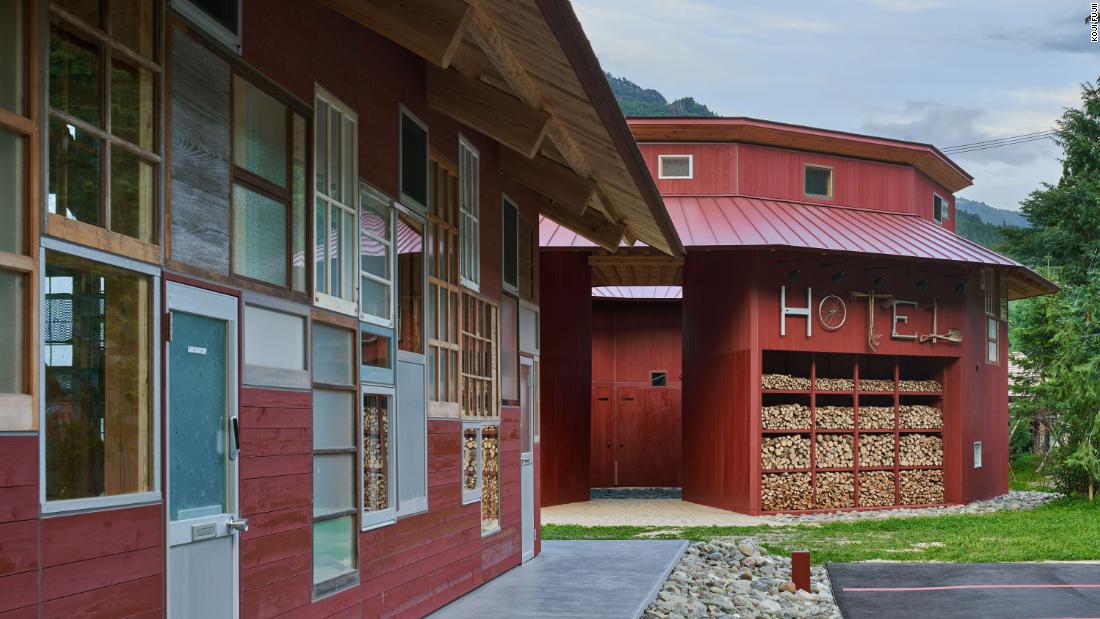
Planks of burgundy cedar picket body 700 mismatched home windows, forming a patchwork duvet of glass panes in opposition to a backdrop of mountain peaks and rolling groves of evergreens.
The facade of the Kamikatsu 0 Waste Heart is placing, to mention the least; nearly as placing as the truth that it was once constructed from trash.
Situated at the banks of the Katsuura River, on a double-horseshoe bend within the far off mountain the city of Kamikatsu in southern Japan, the middle was once opened in 2020 amid the Covid-19 pandemic and has turn out to be a brand new center for the group.
Changing the previous “prefab shack” the place rubbish was once looked after, the brand new heart was once built to help the city’s formidable objective of accomplishing 100% 0 waste, stated Hiroshi Nakamura, head architect for the mission and founding father of NAP Architectural Consulting.
“We would have liked to make this (heart) a spot that the citizens might be happy with,” stated Nakamura.

The middle is helping citizens recycle waste in 45 classes, and includes a boutique lodge for eco-tourists. Credit score: Koji Fujii
Constructed with reminiscences
Nakamura and his group started designing the 0 waste heart in session with Kamikatsu’s citizens in April 2016.
For the remainder construction and inner, nearly the whole lot was once recycled. However making a construction from trash isn’t any simple process. “We in most cases design first after which practice ready-made fabrics to suit the design,” the architect instructed CNN. As an alternative, the design procedure took greater than two years, sourcing and becoming in combination each piece like a jigsaw puzzle.
Some pieces — together with roofing fabrics, metals for waterproofing, bolts and screws for joints, and kit similar to air-conditioning and plumbing fixtures — needed to be new to verify compliance with construction codes and protection requirements, stated Nakamura. On the other hand, restricting the quantity of latest assets nonetheless helped to cut back the construction’s environmental affect, and value, which Nakamura estimated would were double with out the usage of recycled fabrics.

Damaged glass and pottery have been reworked into terrazzo ground, and inexperienced glass bottles right into a recycled chandelier. Credit score: Koji Fujii
The group needed to be resourceful, asking producers for extra or imperfect fabrics that will ordinarily be scrapped, similar to faulty tiles, stated Nakamura.
Damaged glass and pottery have been reworked into terrazzo ground, harvest bins from an area shiitake mushroom farm have been transformed into bookshelves, and a disused mattress from a nursing house was once reworked into a settee. For the construction’s placing facade, the citizens amassed previous home windows, some retrieved from deserted constructions.
“The structure itself was once created with the reminiscences of the citizens, so they have got an attachment to it,” stated Nakamura.
A nil-waste the city
Nestled within the central mountains of Shikoku Island, Kamikatsu sprawls throughout an expansive 27,000 acres. Its settlements cluster alongside a winding stretch of freeway that follows the bends of the Asahi and Katsuura rivers, weaving thru valleys of cedar-covered mountain slopes.
The city’s far off location, an hour’s pressure to the closest town, signifies that Kamikatsu has all the time controlled its personal trash, and has a robust tradition of recycling, stated Momona Otsuka, leader environmental officer at Kamikatsu 0 Waste Heart, who moved to the city in 2020.

Outdated harvest containers from native farms were upcycled into garage cabinets in the neighborhood corridor. Credit score: Koji Fujii
However attending to true 0 waste, firstly centered for 2020, is hard, stated Otsuka: “Some classes of waste, similar to diapers and disposable warmth packs, are exceedingly tough and dear to recycle.”
The 0 Waste Heart was once designed to handle this downside, she stated. The use of a one-way gadget, the middle is split into spaces that make recycling more uncomplicated: a trash sorting and assortment zone, a recycling heart, an training room, and a volunteer-led store the place unfastened, reusable pieces similar to garments, plates, books and electronics are donated and collected by means of citizens. The rest that cannot be recycled is amassed and despatched to an incinerator or landfill within the nearest town, Tokushima.
However the heart is not only about serving to the surroundings: additionally it is for the folks. Citizens in most cases discuss with a few times every week, and with public areas included into the design, it doubles as a group hub for the spread-out the city.
Media protection has created a way of satisfaction in the neighborhood, stated Otsuka, including that the middle is already attracting vacationers: in its first 12 months, 5,000 other folks visited the city, and 1,200 visitors stayed on the lodge, regardless of the Covid-19 pandemic. As tourism opens up, she hopes extra guests will come to “revel in 0 waste in a good approach.”
A recyclable construction
However the Kamikatsu 0 Waste Heart has recycling constructed into its very foundations. Long term innovation or inhabitants decline may just imply a lower in trash, leaving the construction redundant. In anticipation of this, Nakamura designed the construction to be simply downsized, or taken aside solely and recycled.

From above, the construction’s query mark form is obvious. It asks other folks to query their shopper conduct, and use much less. Credit score: Koji Fujii
“The idea that of 0 waste isn’t in regards to the ultimate disposal of waste, similar to getting rid of rubbish (that is going to landfill), however slightly we wish to take into consideration the right way to do away with waste from upstream,” Nakamura added.
Designing the Kamikatsu 0 Waste Heart has motivated Nakamura to hunt out greener structure initiatives, and to be extra inventive in sourcing fabrics — and he hopes that the middle will encourage others to reconsider waste, too.
“My belief of, and frame of mind about rubbish, has modified 180 levels,” Nakamura stated. “I discovered the significance of making new issues whilst inheriting reminiscences.”
